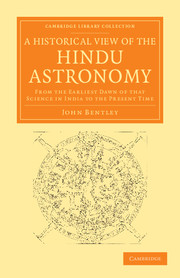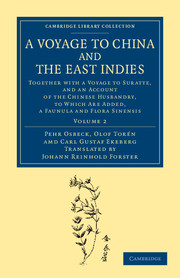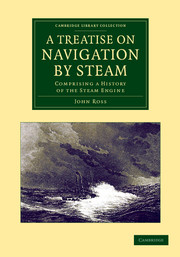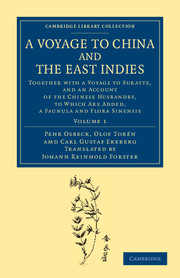Refine search
Actions for selected content:
12661 results in History of science
PREFACE TO THE SECOND EDITION
-
- Book:
- Pharmacographia
- Published online:
- 05 November 2014
- Print publication:
- 20 March 2014, pp ix-x
-
- Chapter
- Export citation
NUMBER IX
-
- Book:
- Fossils of All Kinds
- Published online:
- 05 October 2014
- Print publication:
- 20 March 2014, pp 180-186
-
- Chapter
- Export citation
Mutis in reply
-
- Book:
- A Selection of the Correspondence of Linnaeus, and Other Naturalists
- Published online:
- 05 December 2014
- Print publication:
- 20 March 2014, pp 537-550
-
- Chapter
- Export citation
Herman Boerhaave, M. D. to the same
-
- Book:
- A Selection of the Correspondence of Linnaeus, and Other Naturalists
- Published online:
- 05 December 2014
- Print publication:
- 20 March 2014, pp 204-205
-
- Chapter
- Export citation
APPENDIX to Page 101 supra, containing more particular Instructions for making Observations concerning Presages of Rain in deep Mines, great Quarries or Coal-Pits
-
- Book:
- Fossils of All Kinds
- Published online:
- 05 October 2014
- Print publication:
- 20 March 2014, pp 177-179
-
- Chapter
- Export citation
MAGNETIZATION OF LIGHT
-
- Book:
- Faraday as a Discoverer
- Published online:
- 05 November 2014
- Print publication:
- 20 March 2014, pp 79-89
-
- Chapter
- Export citation
His Correspondence with Ellis
-
- Book:
- A Selection of the Correspondence of Linnaeus, and Other Naturalists
- Published online:
- 05 October 2014
- Print publication:
- 20 March 2014, pp 342-605
-
- Chapter
- Export citation
Class 5 - MINERALS
-
- Book:
- Fossils of All Kinds
- Published online:
- 05 October 2014
- Print publication:
- 20 March 2014, pp 40-43
-
- Chapter
- Export citation
Letters of Peter Ascanius, M.D. to the same
-
- Book:
- A Selection of the Correspondence of Linnaeus, and Other Naturalists
- Published online:
- 05 December 2014
- Print publication:
- 20 March 2014, pp 479-488
-
- Chapter
- Export citation
Monocotyledons
- from I - PHÆNOGAMOUS OR FLOWERING PLANTS
-
- Book:
- Pharmacographia
- Published online:
- 05 November 2014
- Print publication:
- 20 March 2014, pp 629-730
-
- Chapter
- Export citation
Jean Jacques Rousseau to the same
-
- Book:
- A Selection of the Correspondence of Linnaeus, and Other Naturalists
- Published online:
- 05 December 2014
- Print publication:
- 20 March 2014, pp 552-553
-
- Chapter
- Export citation
Letters of Dillenius to Dr. Richardson
-
- Book:
- A Selection of the Correspondence of Linnaeus, and Other Naturalists
- Published online:
- 05 December 2014
- Print publication:
- 20 March 2014, pp 130-160
-
- Chapter
- Export citation
Letters of Mr. Francis Masson to the same and his son
-
- Book:
- A Selection of the Correspondence of Linnaeus, and Other Naturalists
- Published online:
- 05 December 2014
- Print publication:
- 20 March 2014, pp 559-565
-
- Chapter
- Export citation
APPENDIX to Page 107 supra, containing more full, explicit and particular Instructions for making Observations concerning Pogs, Mists, or Clouds, seen frequently upon the Tops of high Hills or Mountains
-
- Book:
- Fossils of All Kinds
- Published online:
- 05 October 2014
- Print publication:
- 20 March 2014, pp 175-177
-
- Chapter
- Export citation

A Historical View of the Hindu Astronomy
- From the Earliest Dawn of that Science in India to the Present Time
-
- Published online:
- 05 March 2014
- Print publication:
- 21 February 2013
- First published in:
- 1825

A Voyage to China and the East Indies
- Together with a Voyage to Suratte, and an Account of the Chinese Husbandry, to Which Are Added, a Faunula and Flora Sinensis
-
- Published online:
- 05 March 2014
- Print publication:
- 05 September 2013
- First published in:
- 1771

A Popular Guide to the Heavens
-
- Published online:
- 05 March 2014
- Print publication:
- 19 September 2013

A Treatise on Navigation by Steam
- Comprising a History of the Steam Engine
-
- Published online:
- 05 March 2014
- Print publication:
- 13 June 2013
- First published in:
- 1828

Life of Thomas Young M.D., F.R.S., etc.
- And One of the Eight Foreign Associates of the National Institute of France
-
- Published online:
- 05 March 2014
- Print publication:
- 21 February 2013
- First published in:
- 1855

A Voyage to China and the East Indies
- Together with a Voyage to Suratte, and an Account of the Chinese Husbandry, to Which Are Added, a Faunula and Flora Sinensis
-
- Published online:
- 05 March 2014
- Print publication:
- 29 August 2013
- First published in:
- 1771
